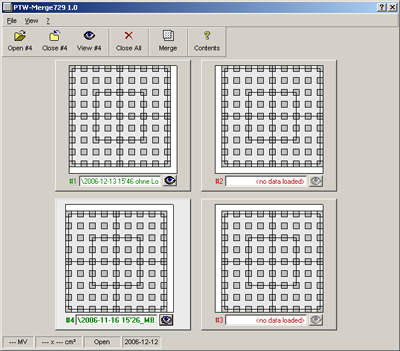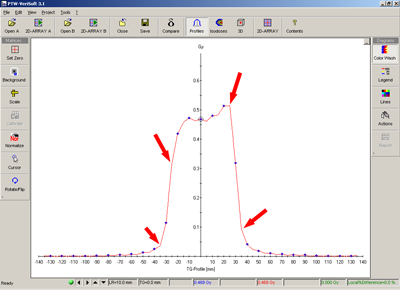Merge729
With the small "Merge729" application which is shipped with VeriSoft, the seven29 can be virtually upgraded to an ARRAY with 2916 ionization chambers. Furthermore, the 27 cm x 27 cm detection area of the seven29 becomes 100% sensitive, thereby eliminating the insensitive volume between the physical chamber locations.
How does it work?
The seven29 has an advantageous design, which is unique in the world of 2D-arrays: the ionization chambers have a 5 mm x 5 mm x 5 mm chamber volume on an equidistant 10 mm grid (see Overview). The nonsensitive phantom material between the chamber cubes is just as wide as the chambers. Therefore, if the measurement of a certain treatment field is repeated after the ARRAY has been shifted by 5 mm and the measurements have been merged, full area coverage can be acheived. The seven29 is the only 2D-array with this interesting geometrical design.

Adding the 4 matrices with the appropriate shift will cover the full area.
The merging is done with the Merge729 software. The resulting dose matrix is saved as a new measurement which contains (2 x 27) x (2 x 27) = 54 x 54 = 2916 measurement values. This file can be opened with VeriSoft in the usual way, just like any measurement containing a single shot.
It is neither required to perform the measurements on the same day, nor to merge four matrices. It is also possible to merge two files laterally or longitudinally.
The first screenshot shows the main screen of Merge729, which is self-explanatory. It displays how the user has to shift the ARRAY between the measurements. Here, two files were added (left column, #1 and #4), with roughly a month between the measurements:
The second screenshot shows an inplane profile along an IMRT field. The merged matrix (full line in red) shows increased resolution compared to the single measurement matrix (blue dots). The red curve has some additional "kinks" (arrows):
It is a question whether merging makes sense for everyday use. I think the native resolution of the seven29 is sufficient in most cases. But for more demanding cases, multiplying the resolution might help. But don't expect a completely different result - it's just a little finer!

